Introduction: Syrian regular forces and their allies continue their military escalation in the northern countryside of Hama in May 2018, but a large portion of the shelling this time affected the agricultural land that people rely on as the main source of livelihood. According to many eyewitnesses and testimonies of the locals in those areas, the Syrian regular forces have escalated their bombardment on the agricultural land located in the towns and cities of Ltamenah and Kafr Zita, Latmeen and Kafr Nbudah[1] since April 2018, and targeted them with various types of weapons, most notably incendiary substances. The bombardment coincided with the annual date of harvest, thus destroying and damaging a large number of agricultural crops.
According to the field researcher of STJ, the northern countryside of Hama is one of the most cultivated areas in Syria because it invests more than 40% from its land in agriculture, plus 62% of the region's locals work in this field. Hama countryside is characterized by its fertile soil and being appropriate for agriculture, in addition it is considered as a food basket that provides the natives with all products of vegetables and fruits. However, with the intensification of military escalation by Syrian regular forces on Hama countryside as of April 2018, many of the lands have become desert and uncultivated, and burning and ruin scenes are visible. Furthermore, the shelling coincided with the arrival of summer and the harvest season.
Cities and towns of Kafr Zita, Ltamenah, and Latmeen, had a larger share of the bombardment since they are adjacent to Syrian regular forces-held areas such as (Halfaya, Mahardah, Zaleen, and Zalaqiyat). STJ's field researcher pointed out that the latter had deliberately burned the lands in order to clear them completely and prevent any offensive operations by the Syrian armed opposition forces, as well as to use it as a technique to press pressure on civilians residing in those areas to give up their support of the opposing factions.
The Food and Agriculture Organization of the United Nations (FAO) issued a report in April 2018 in which it demonstrated that the losses of the agricultural sector in Syria had reached 16 billion dollars since the beginning of the Syrian armed conflict, saying: "Before the Syrian conflict, agriculture accounted for a quarter of the country's Gross Domestic Product and was the main livelihood for almost half the population. Today, a third of the population inside Syria, or 6.5 million people, are facing acute hunger, and the conflict continues to drive the largest refugee crisis in the world."
This attacks came within context of the military campaign launched by the Syrian regular forces to seize many towns and villages in Hama countryside since the beginning of October 2017. STJ had earlier published a report to shed light on the recent military escalation in Hama countryside, the report was entitled "Attacks with Incendiary Substances on Hama Northern Countryside during April 2018, The Attacks Mainly Targeted Cities of Kafr Zita and al-Lataminah, Hama Countryside". In addition, STJ also prepared a report titled "Bombardment Kafr Zita Hospital in Hama Countryside Deprives Thousands of Local People from its Services, the Hospital was Exposed to Several Attacks in 2018, Most Recently was on May 2."
First: 280 Tons of Barley Doomed to Burn Because of Shelling Ltamenah
During April and May 2018, the Syrian regular forces practiced what could be called the "scorched earth" policy in the northern countryside of Hama. Ali al-Hawari, an agricultural engineer in Hama countryside, confirmed this to STJ and said,
"No accurate statistic of the times agricultural lands have been targeted in this harvest in the north countryside of Hama, but since the beginning of April 2018, Syrian regime forces, in the areas they control, almost-daily have shelled agricultural lands in cities of Kafr Zita, Ltamenah and Kafr Nbudah with dozens of missiles loaded with napalm, as well as rocket-propelled grenades and heavy artillery shells. Source of the shelling varied, but the most prominent points was at-Trabee' checkpoint installed in Halfaya. Targeting the agricultural lands in the northern countryside of Hama was not limited in 2018, as they had also been bombed in the previous years, in 2015 and 2017, thus repeating the suffering every year and mounting a heavy burden on civilians although they originally suffer from the ravage of war and its painful consequences like killing and vagrancy; their suffering was increased with another appetite."
A special video footage obtained by STJ showed part of the shelling, which was loaded with incendiary substances on the agricultural lands located between both cities of Kafr Zita and Ltamenah in the northern countryside of Hama on May 23, 2018.
Furthermore, Hussam al-Hasan, head of the Local Council of Ltamenah testified to STJ that the agricultural lands in the city were exposed to an almost-daily bombardment during May 2018, in conjunction with the harvest season that many residents awaited in order to obtain their livelihood and their only income. In this regard, he told STJ,
"Concerning Ltamenah and its surrounding places such as the towns of Zakat and Latmeen, the area of agricultural land there is approximately 65 thousand dunums. Despite of the displacement process in Ltamenah and its surrounding places due to the on-going shelling, up to 90% of its populations are outside the city and live in displacement camps on the Syrian-Turkish border. Regarding the escalation on agricultural land, it has become so evident since the beginning of April 2018. In general, the harvest date for this year was almost 20 days ahead of its usual date compared with each year, due to the long drought that affected the area."
Hussam al-Hasan added that since the beginning of the current harvest season, the Local Council of Ltamenah has conducted a full survey of the losses and damage caused to the agricultural sector in the city as a result of the shelling. On May 9, 2018, based on the survey conducted by the Local Council, the land planted with wheat and barley, which were targeted, estimated to be 20 hectares, in addition to 10 hectares of lands planted with other materials such as clover. Another survey on May 18, 2018, showed that the total number of all affected agricultural lands in Ltamenah and areas around it amounted to 100 hectares, equivalent to 1,100 dunums, including 700 dunums of lands planted with barley, 300 dunums planted with wheat in addition to 100 dunums planted with nigella sativa. And he continued:
"We estimated the supposed production, and it was estimated to be approximately 280 tons of barley and 220 tons of wheat, but all were doomed to burn completely because of the missiles launched by the regime forces stationed at at-Trabee' checkpoint in Halfaya, and in other checkpoints scattered in the villages of Zaleen, Masasnah and Zalaqiyat. The consequences were really deplorable since the population already suffer from considerable material distress due to vagrancy and displacement outside the city, in addition to the scarcity of job opportunities in the liberated areas, as well as the difficulty of getting a livelihood and in general, the poor living conditions. Add to all above a very important thing that is many farmers borrow some money so that they can cultivate their land and every year they hope the land be a source of livelihood for them and their families, but they are helpless against the reality of shelling that destroys all what they have been weary for throughout the year."
The Local Council of Ltamenah released a statement on May 9, 2018, in which it demanded the Syrian Interim Government/the opposition coalition and all the humanitarian organizations to compensate the people affected by shelling of the Syrian regular forces who burned their land and crops. The statement indicated that many locals lived in a state of expectation for the season, but the bombing machine denied them from getting the products of this season.
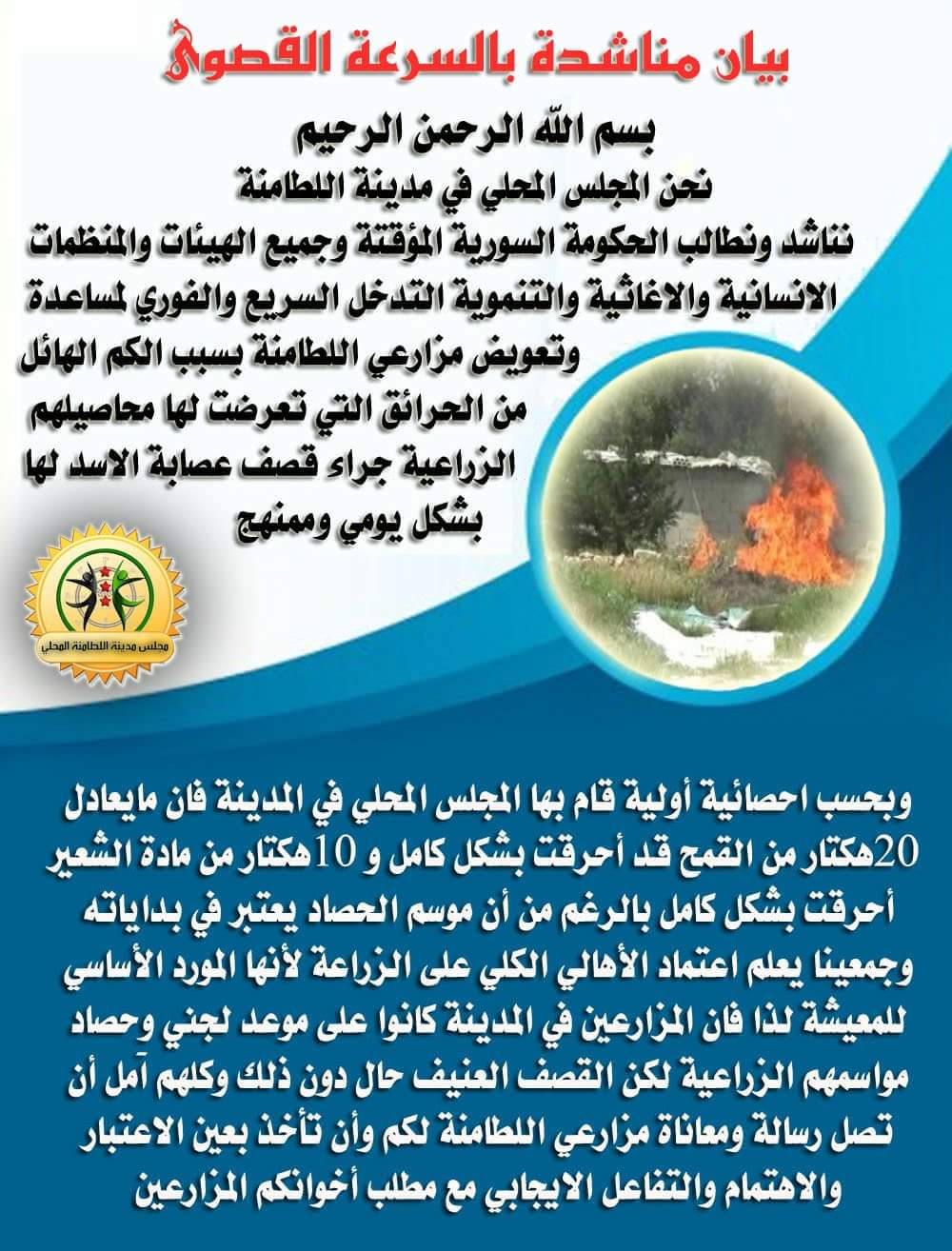
An image of the statement released by the Local Council in Ltamenah city on May 9, 2018. Photo credit: the Local Council of Ltamenah.
A video footage circulated by activists showed some shelling operations that the agricultural lands were exposed to in both cities of Kafr Zita and Ltamenah on May 19, 2018.
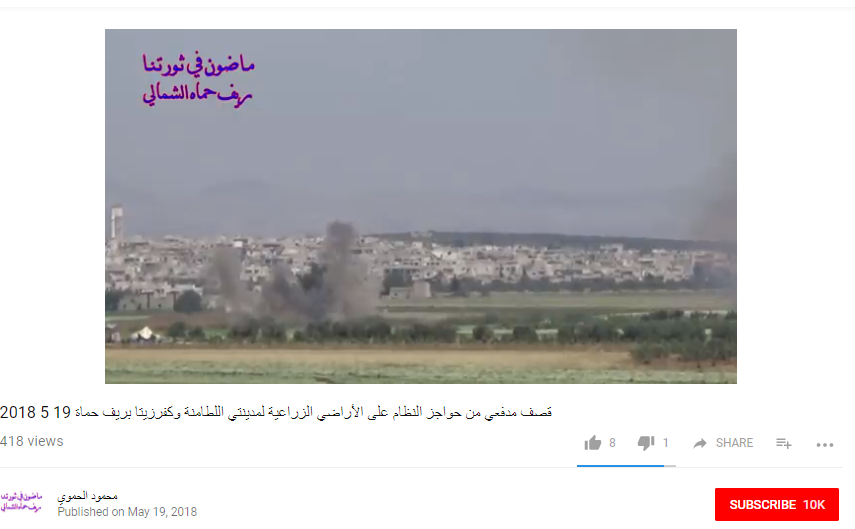
An image taken from the previous video footage that shows dome of the shelling operations May 19, 2018, on the agricultural lands in both Ltamenah and Kafr Zita located in the north countryside of Hama.
Second: Shelling Agricultural Lands with Incendiary Weapons
The incendiary substances were the most prominent weapons used to bomb the agricultural lands in Ltamenah, according to the testimony of Qasim al-Khedeiri, a farmer from Ltamenah, who said he is married with a family of six members living on what their land produces every harvest, but because of the military escalation Ltamenah witnessed during April and May 2018, the features of their livelihood started to change and trait of poverty prevailed. Therefore, Qasim and his family demanded an eventual end for suffering of the population in the northern countryside of Hama in general. In this regard, he spoke to STJ,
"I own a land south of Ltamenah, I plant it and live on its welfare; it is estimated about 30 dunums and is entirely adjacent to the Syrian regime-held Zalaqiyat village. I was forced to plant it with barley due to the high prices of fuels, fertilizers and other materials. The barley is less expensive than other crops and I do not have to be in the land permanently, especially that I can no longer stay in my land fearful of the attacks. Moreover, when I planted the land, the farmers and I were forced to pay taxes (royalties) to the regime's checkpoint installed in Zalaqiyat; we paid up SYP 1000 per dunum in exchange for allowing us to just approach the land and cultivate it."
Qasim al-Khedeiri said on April 28, 2018, Syrian regular forces fired bombs loaded with incendiary substances similar to phosphorous on the agricultural lands in those areas and caused burns in his own land, he stated,
"That day, I waited until the bombing lulled, and then I went quickly to my land, but unfortunately I saw from far that it was burning along with my crop, which I was looking forward. therefore I asked help from the people and then I immediately asked help from the Civil Defense team, but they could not go close to the land fearful of being targeted by the regime forces stationed in Zalaqiyat village, so they returned to their headquarters, while I remained watching my agricultural crop with final glance, after that I went back home but flames had devoured the entire land and had left nothing."
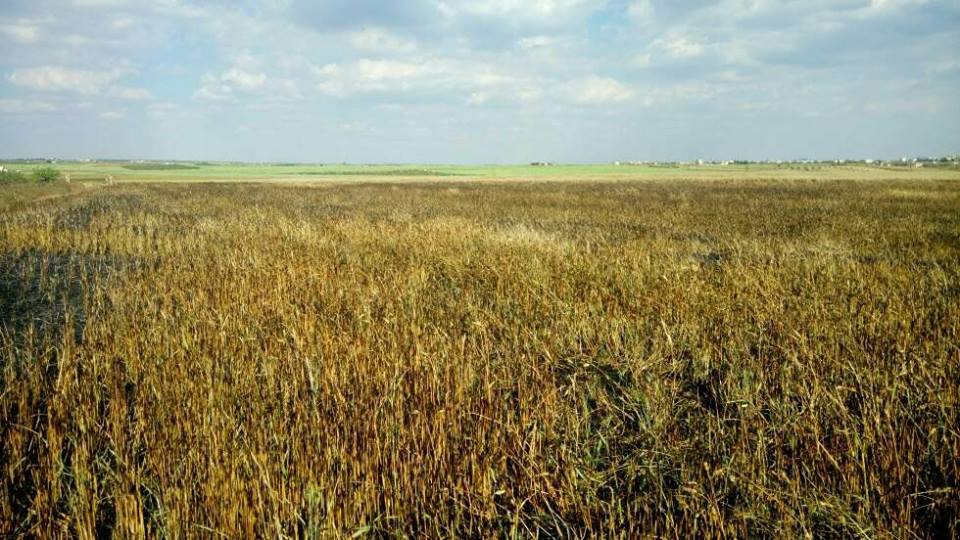
An image of the land owned by the farmer Qasim al-Khedeiri, prior targeting it with incendiary substances on April 28, 2018. Photo credit: STJ
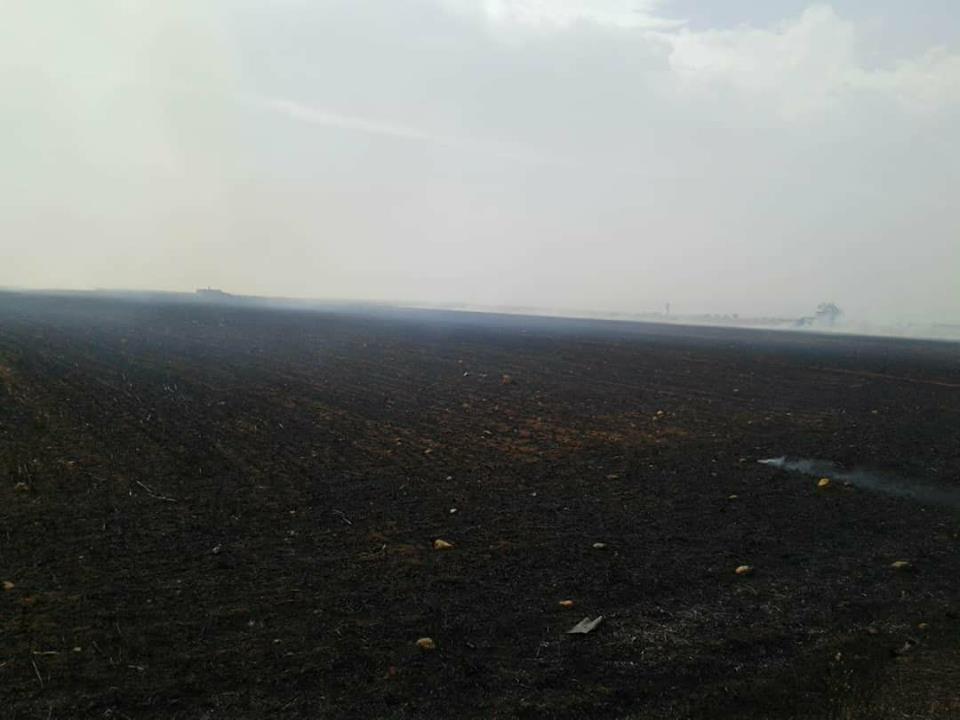
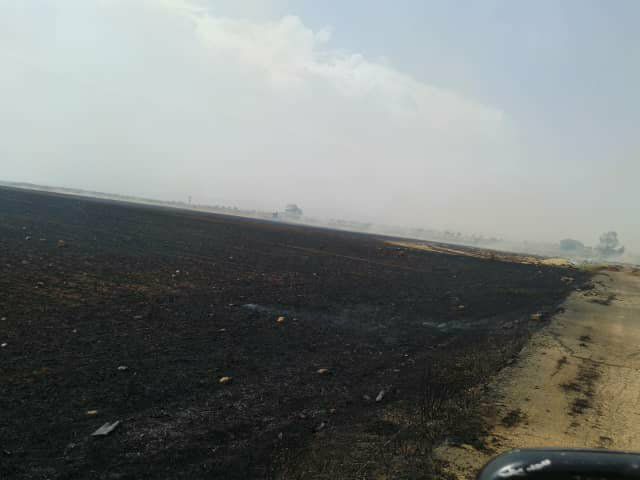
Images of the land owned by the farmer Qasim al-Khedeiri, following targeting it with incendiary substances on April 28, 2018. Photo credit: STJ
Mohammed Darwish, another farmer from Kafr Zita who cultivates and looks after his father's land because his father is very old and can not do the job, said that majority of the agricultural lands in Kafr Zita were exposed to a brutal bombing campaign by Syrian regular forces during May 2018. He added:
"In general I cannot describe what is going on in Kafr Zita, as almost all the agricultural lands have been exposed to fierce shelling by checkpoints scattered on the outskirts of the city in the Syrian regular forces-held areas, including my land. On May 17, 2018, specifically at noon, the regime forces stationed in Mahardah and Hamamiyat targeted my land and several others with incendiary napalm. At the time, I did not get out of my house fearful for my life because the shelling was very intense and no one could go close to the strike location. Consequently, my whole crop burnt in less than half an hour, an area of about 90 dunums, it was all devoured by extreme fires and became like ashes; all my efforts and work was in vain."
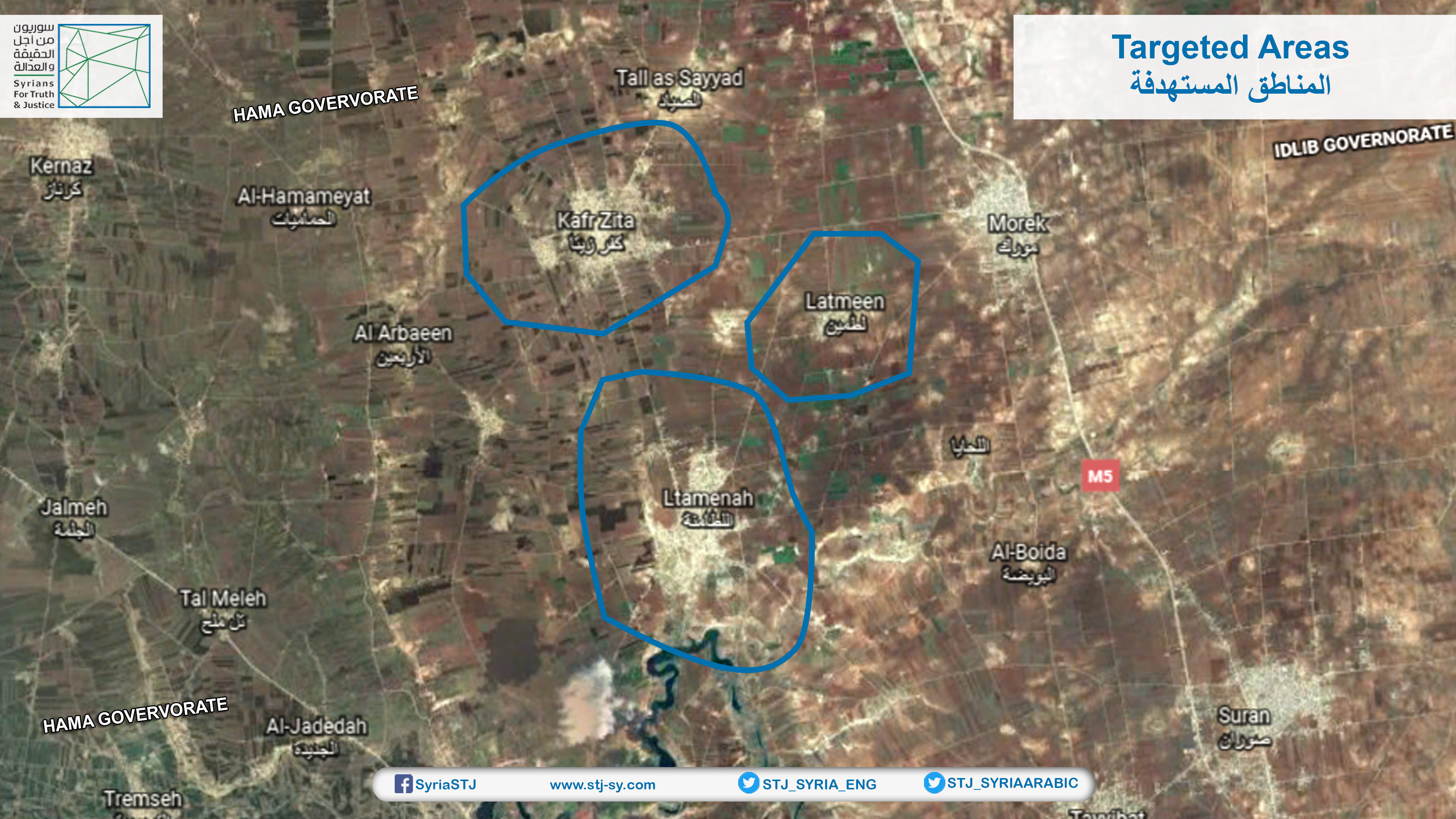
Satellite images showing the size of the agricultural lands surrounding the towns of Kafr Zita, Ltamenah and Latmeen.
[1] Syrian armed opposition factions, notably Jaysh al-Izza and Jaysh al-Nasr, control cities and towns of Ltamenah, Kafr Zita, Latmeen and Kafr Nbudah.

